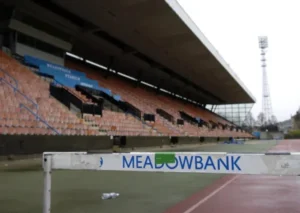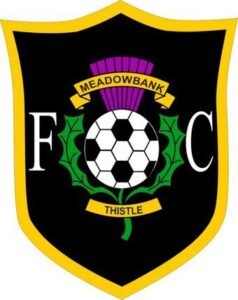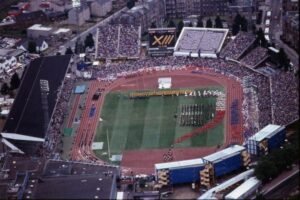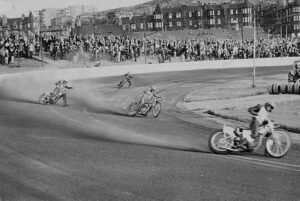
As part of my role as Scottish correspondent for Groundtastic magazine I wrote a number of club articles dedicated to a particular stadium. I hugely enjoyed visiting new towns and cities to unearth some architectural gems of the football world. As a roving reporter I visited Tynecastle, Firs Park, Caledonian Stadium, Victoria Park, Borough Briggs, and completed a tour of the football grounds of the Highland League to name but a few.
I have recently been watching the vlogs of Footy Adventures, which I would heartily recommend to those of you who are interested in football stadiums and architecture. These vlogs are exactly the sort of thing that I would have been producing if things were different. Sadly, I have been held back by a progressive, genetic disease of the nervous system, the related disability, a lack of technical expertise to produce videos and being in Scotland at the wrong time, with the wrong person.
I suppose what I have done as an alternative is to write Every Silver Lining has a Cloud, which is an autobiographical tour of the Welsh Premier League football grounds. For those who have yet to read it – shame on you. I am happy with my own contribution to the world of football architecture, but I can’t help having feelings of envy and jealousy as I watch the ever increasing body of vlogs produced by Footy Adventures.
I have decided to reproduce the club articles and photographs that I managed to take during my time in Scotland. This was a difficult time for myself as I was beginning to feel the full effects of living with Friedreich’s Ataxia. It would obviously difficult having to rely on trains to get me to my desired destination and the fact that I was losing my dexterity meant that it was increasingly difficult to take decent photographs.
I have been unable to locate some of the photographs that I took while in Scotland. Should you need proof, then you only have to find a copy of Groundtastic to see that I have been credited for taking some photos. For the purposes of this blog about Meadowbank Stadium, I have used some of my photographs along with others that I have found on the internet. These photos are of a high standard, and I do not claim to have produced these myself. Where possible, I have included links to the original pages where I found these photos. Simply click on the photos to be redirected to the page where I found the originals.
Overall, I am happy with what I wrote, and hope the following is of interest to some of you.
***

On December 4 2006, Edinburgh City Council announced its intention to sell Meadowbank Stadium to private property developers, resulting in the loss of a historic sports centre and the construction of several hundred homes. The City Council could raise more than £50 million from the sale of Meadowbank, which would then help to pay for a replacement multi-sports complex at Sighthill and a long-awaited refurbishment of the Royal Commonwealth Pool. In addition, sports facilities would be retained in the redeveloped area as part of a blueprint with which potential buyers would have to agree.
On the face of it such plans seem straightforward enough but these proposals have caused quite a stir in Edinburgh.

Meadowbank Stadium is a multi-purpose sports facility, constructed between 1967-1970 at a cost of £2.8 million, that held the Commonwealth Games of 1970 and 1986. The 16,000 capacity stadium boasts an eight-lane running track that circles a grass pitch. A large, steep grandstand can accommodate 7,500 while uncovered benches and terracing stretch around the rest of the track. There is a large electronic scoreboard at one end of the pitch while the arena is lit by four towering floodlights, which stand in each corner of the ground.
The 25-acre site also includes a vast array of indoor facilities such as squash courts, gym, climbing wall, a sports hall ideal for hosting boxing or wrestling, fitness studio, gymnastics room, conference rooms and a creche. In addition, the sprawling centre is home to three all-weather pitches, basketball courts and one of only two velodromes in Scotland. It is little wonder that there has been such a backlash since the council announced their plans.
Protesters argue that Meadowbank is more than just a sports centre and should be cherished as an important part of Edinburgh’s sporting and cultural heritage. The strength of feeling on this issue seems to stem from the lack of public consultation by Edinburgh City Council before the decision was made to sell a public asset for private profit. As David Baxter of the Save Meadowbank campaign said: “We believe the decision to demolish the stadium is flawed because there was no public consultation. We would like the council to reverse that decision pending a consultation with those who use Meadowbank.”
Edinburgh City Council claim that demolition of Meadowbank is the only option as refurbishment of the outdated arena would not be possible and prove too expensive due to funding criteria laid down by sportscotland. City sports leader Councillor Donald Anderson claimed the cost of refurbishing Meadowbank would be 80 per cent of that of building a new stadium, adding: “We are not magicians, and we don’t have a spare £50 million.” Yet sportscotland’s Chief Executive Stewart Harris has recently said money could have been made available to refurbish and the decision to sell Meadowbank to developers was the Council’s alone.

Even the planned replacement complex at Sighthill has been criticised. Construction of the proposed athletics and rugby arena was due to begin in January 2009 and be completed in the first half of 2011 and was to include a 6000-capacity sports arena, which can have its capacity raised to 10,000 for major events, as well as two grass sports pitches, an all-weather sports pitch, two sports halls, a gymnastics hall and an indoor running track. In addition, Sighthill has better transport links to the airport, motorway and bypass – but crucially not to the east side of Edinburgh. Opponents point to the fact that East Edinburgh is already set to lose the Pitz football pitches in Portobello, Leith Waterworld, and Portobello Golf Course and cannot afford to lose this popular and well-used public facility.
Bill Walker, a senior coach who has trained dozens of Olympic and Commonwealth stars, said demolishing Meadowbank would risk losing a generation of athletes. He said: “If the centre closes, a lot of young athletes will just give up the sport. People come from all over Edinburgh and East Lothian to use the track. They’ll be left with nowhere to go. We should be encouraging a new generation of youngsters, not taking this away from them. A lot of coaches won’t go out to Sighthill if it moves there. The council aren’t listening to those who use the centre.” In addition, Sighthill would be much smaller than Meadowbank and cater for fewer sports.
A new, but much smaller, community sports centre would be built at Meadowbank on the remaining land. City planners have identified the current site of the stadium as the preferred option for the facility, which is expected to feature a sports hall, a gym and two fitness studios, a martial arts room, squash courts and a floodlit sports pitch. However, protestors seem puzzled as to why this smaller facility isn’t built at Sighthill while Meadowbank is refurbished. This plan would seem to support the council’s leisure strategy, which aims “to make Scotland’s Capital the most physically active city in Europe by 2020″. Surely, this strategy would be damaged with the demolition of Meadowbank?
The ‘Save Meadowbank’ campaign has had much support. Over 3,000 people signed an online petition, which was also backed by MSPs and celebrities such as Edith Bowman and The Proclaimers. Meanwhile, over 600 protestors marched from Meadowbank Stadium to the City Chambers on March 30. Just before going to press it appears that these efforts have been rewarded with the news that Edinburgh City Council has agreed to go back to the drawing board. A working group will be set-up with a brief to “re-open and examine the principle of the sale of the Meadowbank site either in whole or part”. Councillors also agreed that “no parameters are set within which the group must confine its deliberations.”
The motion as it stood clearly continued to pre-suppose the sale of the Meadowbank site,” said campaign spokesperson Heather Peacock. “The amendments broaden the consultation group’s remit sufficiently to address one of our main concerns over the motion. Unfortunately the working group does not include representation from the Save Meadowbank campaign group. Nor does it allow for full public participation in the consultation process. We are also concerned that the working group must prepare an interim report for presentation to the council by 28 June 2007. This seems an incredibly short timescale for such an important debate. Our campaign to save Meadowbank has been successful thus far. But the job is not complete and we will continue to work and lobby until public opinion becomes central to the debate.”
For more information on the Save Meadowbank campaign, visit www.savemeadowbank.org or the campaign blog at http://edinburgh-meadowbank.blogspot.com
***
Groundtastic readers will probably be most interested in Meadowbank Stadium’s use as a football ground.

In 1974, Ferranti Thistle were admitted to the Scottish Football League and came to an agreement with Edinburgh Council to play their home games at the then state of the art Meadowbank Stadium. When Ferranti had to change their name due to strict SFL sponsorship rules, Meadowbank Thistle we formed. They played at the stadium from 1974 until 1995. During this time, Meadowbank never exactly set the world on fire and despite an encouraging attendance of 4,500 on their home league debut [August 10 1974 v Albion Rovers], this was as good as it got. During their final season, Thistle only attracted an average attendance of 290 – the lowest in the league. At the beginning of the 1995-96 season they played on at Meadowbank under the new name of Livingston, until the new stadium at Almondvale, 15 miles away down the M8, was finally ready in November.
Meadowbank Stadium is often cited as one of the worst grounds to ever see Scottish Football League action. There were vast expanses of unused seating, with most fans located on one side of the ground. The running track created a great distance between the fans and the pitch. These factors all contributed to a lack of atmosphere in the ground and few will miss Meadowbank as a home for football.
In August 1995 the Council granted Edinburgh City FC permission to hire Meadowbank Stadium for up to 26 Saturdays a season with effect from January 1996. This East of Scotland league club still calls Meadowbank home.
***

One important angle that I do not feel the Save Meadowbank campaign has exploited is the historical value of the site before the current stadium was opened in 1970. The current stadium was built on a large site that previously incorporated a recreation ground (AKA New Meadowbank) and a separate arena that acted as a speedway track and football ground (AKA Meadowbank and later Old Meadowbank).
The highly respected Leith Amateurs Club had previously used Meadowbank for football when, in 1936, former Scottish League members’ Leith Athletic FC began to call it home. The club was not enjoying a successful period on the pitch and coupled with the coming war this gave them little time to develop the enclosure. Meadowbank consisted of a five-acre site with a wide oval track around the playing area but this resulted in a rather distant view of matches. The club built nothing more than wooden dressing rooms, club offices and basic shelter for supporters. During the Second World War, the Army used Meadowbank as a motor transport depot. This resulted in an unplayable ground when Athletic reformed in 1945.
In fact, conditions were so bad that the club had to use the adjacent Corporation owned Recreation Ground from 1946-47. This ground had previously been a velodrome. There were few facilities for spectators around the oval shaped pitch and surrounding track, other than a narrow embankment along the South side and West end. Elsewhere there were only flat standing areas and a Pavilion, which also probably incorporated a small covered Stand, at the East end.
While Athletic used the Recreation Ground, club members began redeveloping Old Meadowbank. Concrete Terracing was provided all around the oval track and the Grandstand from the former Gymnasium Ground of St Bernards was re-erected on the South side. The final capacity was variously claimed between 24,500 and 30,000. Despite Athletics’ problems in attaining a higher standard and attracting better crowds, the supporters continued improving the ground virtually to the end, building a cover for 2,000 spectators on the North side. However, attendances did not improve, finances were tight and the inevitable was never far away. In 1954, Leith Athletic played their last home match at Meadowbank and were officially liquidated in May 1957. For a period following the demise of Athletic, Murrayfield Amateurs used the ground until they faced the same fate as the previous occupants.

Football was not the only sport played at Old Meadowbank. In 1948 the stadium hosted its first speedway meeting. The Edinburgh Monarchs raced here until 1954 when the post-war entertainment tax started to make the sport unprofitable. The entertainment tax was later scrapped, and the sport was reintroduced to Edinburgh in 1960 but the Monarchs were forced to leave Old Meadowbank in 1967 to allow the stadium to be re-developed for the 1970 Commonwealth Games. The Monarchs are now based at the Armadale Stadium, in West Lothian. It is ironic that the stadium has been used extensively for professional sporting activities since 1967, as speedway fans were advised then that the stadium could not host professional sports due to Government funding rules.
***
Glenogle Baths

There is a similar campaign being fought in the Stockbridge area of Edinburgh where a Victorian swim centre could be sold off for housing. Refurbishment of Glenogle Baths was originally scheduled to start in January 2006. Instead this has been postponed several times allowing building to deteriorate further. It has come to light that the Council is now considering a plan to ‘redevelop’ Glenogle Swim Centre in partnership with a developer.
Opponents are concerned that any ‘redevelopment’ may lead to the demolition of this much-loved historic building and have made it clear that they will not be softened by promises of a new pool. Rather admirably the main objective remains the preservation of this B-listed building. As stated on the campaign website: “We wish to ensure that the Council fulfils its promise to refurbish and maintain the Glenogle Baths as it has done with the other 4 Victorian baths in Edinburgh.”
For more information on the campaign to save Glenogle Baths visit www.saveglenoglebaths.com

